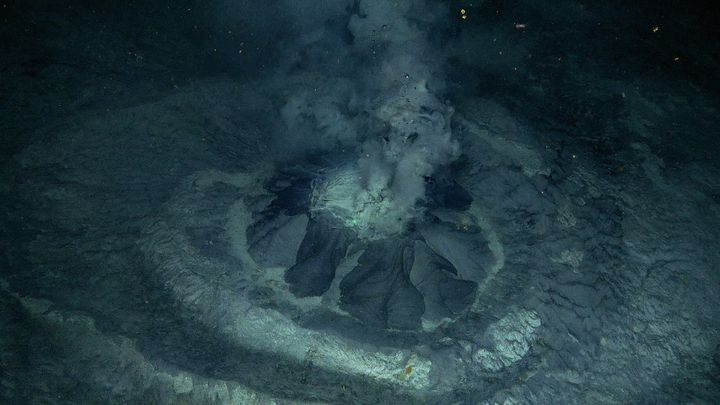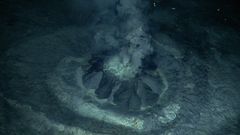Mud Volcano Discovered May 7, 2023 in the Barents Sea

The AKMA3 oceanographic expedition led by scientists from UiT, The Arctic University of Norway, in partnership with REV Ocean, has discovered the second ever mud volcano found within Norwegian waters, the Borealis Mud Volcano. This unusual geological phenomenon was discovered onboard the research vessel Kronprins Haakon with the piloted submersible vehicle ROV Aurora in the Southwestern Barents Sea at the outer part of Bjørnøyrenna (Outer Bear Island Trough). It lies at approximately 70 nautical miles south of Bear Island and at 400m deep.
The newly discovered volcano rests inside a crater which is approximately 300m wide and 25m deep and is most likely the result of a catastrophic, natural blow out that abruptly released massive methane just after the last glaciation period, 18,000 years ago. Currently, the Borealis Mud Volcano, which is ca 7 meters in diameter and 2.5 meters high, continuously emits fluids rich in methane. Methane is a highly potent climate gas when it reaches the atmosphere. This discovery will help scientists understand the potential impact of localized but persistent in-time phenomena on the global methane budget and its impacts on the ecosystems.
Professor Giuliana Panieri, expedition leader and Principal Investigator of the AKMA project, said: “We do not exclude the possibility of discovering other mud volcanoes in the Barents Sea. It is only thanks to collaborative team teamwork and advanced technology that these results can be achieved. Seeing in real time an underwater mud eruption reminded me how “alive” our planet is”.
The crater hosts a rich community of seabed life, thriving on the steep flanks of carbonate crusts formed several thousands of years ago. This unique habitat includes sea anemones, sponges, carnivorous sponges, sea stars, corals, sea spiders and crustaceans. Within the crater, there are also areas of extensive bacteria mats and tube worms.
Professor Stefan Buenz, expedition co-leader, said “Exploring the ocean floor and discovering new methane seeps is like finding hidden treasures. It's full of surprises. We have found thousands of seeps. Yet, every time we go down to the ocean floor, we come away with a feeling that we are just beginning to understand the vastness and incredible diversity of seep systems.”
Science Director of Ocean Census and REV Ocean, Alex Rogers, an expedition participant, said: “During this expedition we have discovered that these blow-out craters are unique refuges from human impacts like trawling for fragile marine animals such as corals and sponges.”
The international research team onboard know of only one other mud volcano in existence in Norwegian waters, the Håkon Mosby Mud Volcano discovered in 1995. The Håkon Mosby Mud Volcano lies at 1250m deep on the seafloor south of Svalbard at 72°N. These peculiar features are direct windows into the Earth's interior since they erupt predominantly water and fine sediments from depths of several hundred meters to few kilometres providing a window into past environments. Understanding the evolution and the fluids' composition help us comprehend their potential impact on the global methane budget and can inform about what happens on other planets.
Beckett Colson, WHOI postdoctoral investigator, said “It has been an honour to be part of this very international team of students and scientists. I joined the expedition to operate a new real-time methane instrument, but it has been incredible to explore these beautiful habitats.”
Irene Viola, an Erasmus student at UiT, said “As a student that studied and saw mud volcanoes only on land, seeing one on the seafloor was an amazing experience. You could sense the surprise, the excitement, the happiness spreading from the team the exact moment we saw it on screen. My first thought was, "I want to go down there, stick my arm in it!"
The AKMA3 oceanographic expedition has a multi-disciplinary team of scientists and students onboard, and is part of the Advancing Knowledge of Methane in the Arctic, a project funded by the Norwegian Research Council, which includes the following partners: WHOI Woods Hole Oceanographic Institution in the US, La Rochelle Université France, Università degli Studi di Milano-Bicocca in Italy, Universidade de Aveiro and CESAM in Portugal, Centre for Deep Sea Research and Department of Biological Sciences at the University of Bergen in Norway, Ocean Census and the Norwegian Petroleum Directorate.
The team is completing the third and final AKMA mission and is returning to shore May 10th after a twelve-day cruise in the Barents Sea.
Additional quotes:
Oscar Cosserat, PhD student from La Rochelle University “Live learning from scientists learning from the ocean was not quite planned in my PhD journey. The more I learn from the ocean, the less I know about it”.
Yan Tu Ting, BSc. in Marine and Antarctic Science and majored in Geology and Geosciences from the Earth Observatory of Singapore “I never thought that I would have the chance to go to the Arctic circle, and to witness and participate in all the science and discovery happening here just makes it even more amazing. Really worth the cold”.
Vasilki Petsakou from Greece – Master student at National and Kapodistrian University of Athens
“Akma3 cruise for me was four years of bachelor's degree and two years of master's degree, all concentrated in fourteen days. But then mud volcano happened! Being present at that moment is a feeling that can’t be described! I get to be part of something that other scientists need maybe a lifetime to experience! I don’t think there is a good enough word for that, just grateful looking forward to what’s next!”
Contact
Giuliana Panieri, Department of Geosciences, UiT The Arctic University of Norway, giuliana.panieri@uit.no
Alex David Rogers, Science Director REV Ocean and Ocean Census,alex.rogers@revocean.org
Keywords
Contacts
Ellen Kathrine BluddKommunikasjonsrådgiverUiT Norges arktiske universitet
Tel:45002395ellen.kathrine.bludd@uit.noImages

About UiT Norges arktiske universitet
Subscribe to releases from UiT Norges arktiske universitet
Subscribe to all the latest releases from UiT Norges arktiske universitet by registering your e-mail address below. You can unsubscribe at any time.
Latest releases from UiT Norges arktiske universitet
Toppforskere på kunstig intelligens samles i Tromsø5.1.2026 10:08:08 CET | Pressemelding
270 KI-eksperter fra nært og fjernt møtes ved UiT for å dele siste forskningsnytt. Et av formålene er å styrke internasjonale bånd og samarbeid på tvers av det globale KI-miljøet.
Zachariassen skal leie utgreiing22.12.2025 14:09:46 CET | Pressemelding
På oppdrag frå regjeringa startar UiT no arbeidet med å greie ut korleis eit nasjonalt kompetansesenter om fornorskingspolitikk og urett kan vere organisert og kva oppgåver det kan ha. Førsteamanuensis Ketil Zachariassen skal leie arbeidet.
Verdens dypeste gasshydrat-kaldkilde oppdaget i Arktis22.12.2025 11:00:00 CET | Pressemelding
Et internasjonalt forskerteam ledet av UiT Norges arktiske universitet har oppdaget det dypeste kjente området i verden der metan siver ut fra havbunnen.
UiT lanserer 16 nye mikroemner – tilpasset et arbeidsliv i endring12.12.2025 10:51:56 CET | Pressemelding
Praktisk KI, logikk og argumentasjon, programmering og mangfoldskompetanse er noen av UiTs nye mikroemner.
Minneord: En drivkraft i nord har forlatt oss6.12.2025 14:28:19 CET | Pressemelding
Det er med stor sorg UiT Norges arktiske universitet mottok budskapet om at tidligere rektor professor Anne Husebekk gikk bort 05.12. etter noe tids sykeleie.
In our pressroom you can read all our latest releases, find our press contacts, images, documents and other relevant information about us.
Visit our pressroom
